«TRS instances» tab¶
Tab displays list of TRS instances:

TRS instances list¶
| Field name | Description |
|---|---|
| Name | TRS instance name, it is assigned by the user upon creation. It also changes in the general list and is link to go to detailed information about a specific instance.s |
| Project | Project that owns the TRS instance. |
| IP Address | Local IP-address of TRS instance, assigned by the system automatically at stage of creation. |
| Size | Powers of the TRS instance are set when creating TRS instance. |
| Status | Instance state as determined by OpenStack services. |
| Task | Displaying the progress of the task assigned to the TRS instance. Task can be set both by the system and by the user. For example, create, archive, shutdown, etc. |
| Operation mode | TRS instance operating mode. It is set when creating a instance, changing the operating mode for TRS instance is not allowed. |
| Assigned | Indication that the TRS instance is assigned to user(s) or group. |
Sorting and filtering tools are available for the list of TRS instances. Sorting is available for all fields. It is possible to sort the objects marked with a check mark. Filtration is performed according to following parameters:
- Name is TRS instance name. Incomplete input is allowed;
- Project is TRS instance project. Incomplete input is allowed;
- IP address is IP address of the instance. Incomplete input is allowed;
- Size is flavor of TRS instance. Incomplete input is allowed;
- Status is instance status. Incomplete input is allowed;
- Availability zone of instance. Incomplete input is allowed;
- Task is task name of the TRS instance. Incomplete input is allowed;
- Power is power status of the TRS instance. Incomplete input is allowed;
- Operation mode is TRS instance operating mode;
- Assigned is indication that the TRS instance is assigned to user(s) or group;
- Instance ID is instance identifier, it is specified in the tab with detailed information. Incomplete input is allowed.
Also, user can view detailed information about TRS instance. Detailed information about the object opens in separate block on the right side of the page when you click on TRS instance name link. This does not close the list of objects and is displayed on the left side of the page. To close block of detailed information use the  button, to open a block of detailed information use the button
button, to open a block of detailed information use the button  .
.
Detailed information is presented in several tabs:
«Overview» tab¶
Tab displays detailed information about selected TRS instance:

Detailed parameters of TRS instance¶
Note
Names of the security groups and images are links to the pages of these objects. This allows to navigate to the required security group or image directly, bypassing the process of searching and switching between tabs.
«Interfaces» tab¶
Tab displays interfaces connected to the selected TRS instance:

TRS instance interfaces¶
«Console» tab¶
Tab provides access to console control of the selected TRS instance:

Console of TRS instance¶
«Action Log» tab¶
Tab displays information about history of operations on the TRS instance:

TRS instance action log¶
| Field name | Description |
|---|---|
| Request ID | Request identifier. |
| Parent request | Identifier of the request, which is the parent of this one, for example, if an action was performed on a request from RSclient or Scheduler. If the action is performed on request from the Dashboard, then there is no parent request. |
| Action | Action name. |
| Start time | Date and time of the task start in the format: dd.mm.yyyy, hh.mm.ss. |
| User | Name of the user who initiated the action. |
| Result | Result of the action. Possible values are:
|
| Result details | Detailed description of the result. Also, if the action was performed during the execution of a scheduled task, the task identifier is indicated. |
Sorting and filtering tools are available for the list of volumes snapshots. Sorting is available for all fields. It is possible to sort the objects marked with a check mark. Filtration is performed on all fields, except for “Start time”.
«Scheduled tasks» tab¶
Tab displays list of scheduled tasks on TRS instance:

Scheduled tasks list¶
Sorting and filtering tools are available for list of scheduled tasks. Fields are sorted in ascending and descending order. Filtration is performed according to following parameters:
- ID is task ID. Incomplete input is allowed;
- Task name. Incomplete input is allowed;
- Action is action name. Incomplete input is allowed;
- Type is the type of task execution. Only exact input is allowed;
- Last execution state is task status. Incomplete input is allowed.
To view detailed information about specific task, click on the “More” button. All actions are described in more detail in “Scheduled Tasks” tab.
On tab there is button “Schedule”, when you click on it, you go to the form for scheduling task on the object.
«Metrics» tab¶
Tab displays performance data for the selected TRS instance:

Displaying TRS instance performance statistics¶
Also, each of graphs is clickable, so you can maximize and view each of parameters of TRS instance:

CPU and RAM usage graph¶
By default, only metrics are collected by:
- percentage of CPU utilization;
- percentage of RAM utilization.
It is possible to customize the output of other metrics. Go to the «Integration / Monitoring» tab and use the «Settings» function.
«Sessions» tab¶
Tab displays detailed information about connections to the selected TRS instance:

List of connections to TRS instance¶
| Field name | Description |
|---|---|
| Login | Name of the user who connected to the TRS instance. |
| Created | Date and time of connection to TRS instance. |
| Closed | Date and time when the connection to TRS instance was completed. |
| Connection | Connection type. Possible values are:
|
| Client | Client or web browser version is displayed depending on type of connection. |
| OS | Operating system used when connecting. |
| IP | IP-address from which connection is made. |
Sorting and filtering tools are available for all displayed fields. The fields are sorted in ascending and descending order. Filtration is performed by fields:
- Login;
- Created;
- Closed;
- Connection;
- Client;
- OS;
- IP.
«Groups» tab¶
Tab displays list of all groups that are assigned to TRS instance within the current domain:

List of TRS instance’s groups¶
«Users» tab¶
Tab displays list of all users that are assigned to TRS instance within the current domain:

List of TRS instance’s users¶
| N | Action | Description |
|---|---|---|
| 1 | Shelve instance | Shelving TRS selected instance. Instance status will change from «Active» to «Shelved Offloaded». |
| 2 | Start instance | Starting TRS selected instance. Instance status will change from «Shutoff» to «Active». |
| 3 | Shut Off | Shutting off the instance. Instance status will change from «Active» to «Shutoff». |
| 4 | Schedule | Execution of the selected action on TRS instance at specified point in time. It is also possible to repeat the action after a certain period of time. Scheduling is only possible if there are available actions. |
| 5 | Launch TRS instance | Creating TRS instance. |
| 6 | Clone instance | Copying an existing TRS instance with the ability to change its parameters. Parameters cannot be changed with full cloning. |
| 7 | Assign to Users | Managing user access rights to TRS instance. |
| 8 | Rebuild instance | Modifying TRS instance by changing an image or partitioning volume. |
| 9 | Show metrics | Displaying statistics of the selected TRS instance. |
| 10 | Pause instance | Pausing TRS instance. Instance status will change from «Active» to «Paused». |
| 11 | Unshelve instance | Unshelving the selected TRS instance. Instance status will change from «Shelved Offloaded» to «Active». |
| 12 | Wake up instance | Wake up windows instance that has entered sleep state. Power status of the instance will change «Suspended» to «Active». |
| 13 | Edit instance | Changing the name, description, and security groups of instance. |
| 14 | Unpause instance | Unpause instance. Instance status will change from «Paused» to «Active». |
| 15 | Delete instance | Deleting instance. When deleting, all tasks scheduled for it are deleted along with instance. |
Listed actions are available for execution with respect to one selected TRS instance - by selecting the desired action in the “Actions” field of corresponding line in the list of instances:
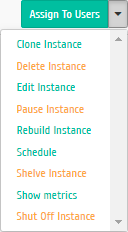
Individual actions on TRS instance¶
You can also perform actions on group of pre-selected TRS instances. To do this, you need to mark the required instances and select group action:

Group actions on TRS instances¶
In addition, actions on TRS instance or group of instances can be scheduled to be performed at specific point in time. Also, actions can be scheduled to be performed regularly.
To schedule action for one instance, select the “Schedule” action from the list.
To schedule task for TRS group of instances, select the required instances and select the “Schedule” group action.
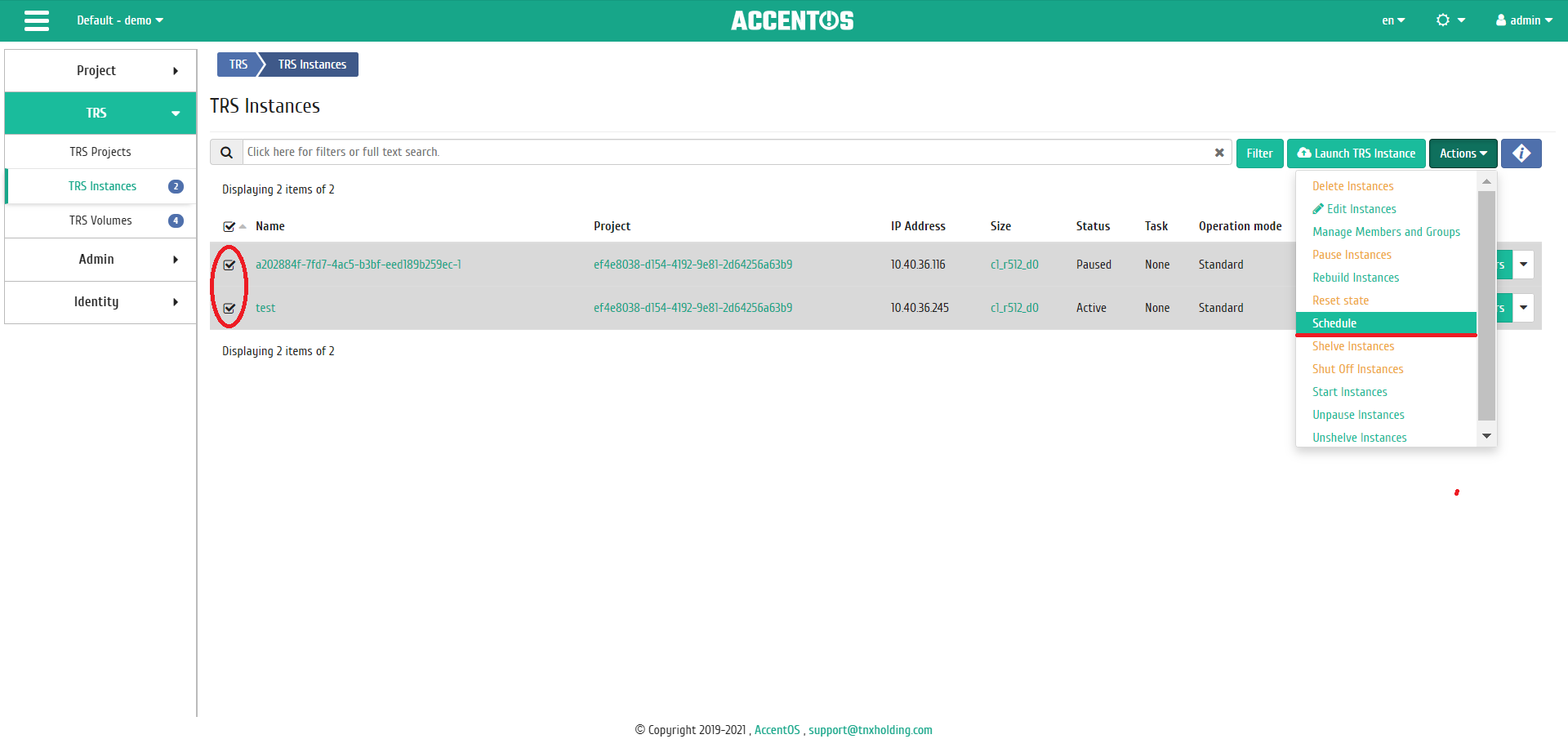
Scheduling on TRS instances group¶
Features of work¶
Creation of TRS instance¶
In the general list of all instances on the control panel, open the creation wizard using “Launch TRS instance” button:

TRS instance creating window¶
In the window that opens, indicate:
- TRS project, selection of the required project. This field is required;
- Number of instances is the number of instances to start. It is possible only within limits of available resources. This field is required;
- “I confirm, that I am not using a clustered file system” is enabling or disabling confirmation that a clustered file system is not used. Without confirmation, only one TRS instance can be started;
- Instance name is optional field; if value is empty, the name is generated automatically;
- Description is description of the TRS instance. The field is optional;
- Instance users, managing TRS instance users within the selected project. For user without administrator rights, assignment is possible only on instances of available projects;
- Instance groups, management of TRS instance groups within the selected project. Function is available only for the administrator;
- Volumes, attach volumes to TRS instance. When starting several instances at once, tab is not displayed, since it is impossible to connect volumes to several TRS instances at same time.
Note
Maximum length of TRS instance name is 245 characters, it has character format and does not support variables, it can include Latin, Cyrillic, and special characters. If the instance name is not specified by the user in create form in Dashboard, the automatically generated TRS instance name is hexadecimal code (32 characters) separated by hyphens (for example, ** 4889ae9a-fb29-4b54-9843-eb7a4f ). When creating TRS instance via CLI REST API, the request for the instance name is also mandatory, auto-generation of names is not available. If the number of started instances was specified in the creation form more than 1, then the postfix “-№” is added to the instance name entered by the user or generated automatically, where № is the serial number of instance created by this request (for example, **trs- 1, trs-2, etc.). When creating TRS instance on request from RSclient or the web interface, instance name is generated based on the following mask: TRSProjectName_DATE_TIME (for example project1_2018-11-16_12:20:16).
Important
“Instance Users” and “Instance Groups” tabs will not be available until TRS project of the created instance is selected.
Follow instructions on pages of the wizard to select the options that are appropriate for the operating system of instance. We complete creation procedure with “Save” button. After that, correctly created instance will be displayed in the general list. Otherwise, the system will return you to the wizard window indicating reasons for the impossibility of its creation.
After the successful creation procedure is completed, the instance may take time to finalize all systems. Ultimately, the instance is displayed with the status “Active”. When a TRS instance is created, security group associated with it is automatically created.
Note
When you delete TRS instance, associated security group is also automatically deleted.
Creation of TRS instance with placement in permanent storage system¶
Cinder is used as a backend for bootable disks.
To create a TRS instance with placement in a permanent storage system, you need to do the following:
For the instance running from volume, take a snapshot (in the “Project” or “Administrator” section):

Window for creating snapshot of the TRS instance¶
If necessary, make the resulting image public (in the Administrator section):

Image editing window¶
Specify the resulting image in the TRS project properties (select it by default):

TRS project editing window¶
Start the TRS instance, make sure that the instance starts from volume.
Note
Volumes for new TRS instances will be created with the size specified in the flavor of the original instance, and not with the size specified in the flavor of the TRS project.
Editing TRS instance¶
Function allows to edit name, description and assigned security groups of the selected instance. It is available in the general list of all instances. After calling the action in the window that opens, set the required parameters:

Instance data change window¶
End procedure with confirmation button.
Cloning of TRS Instance¶
Function allows to create copy of an existing TRS instance. Available in the general list of all instances. After calling the action in the window that opens, set necessary parameters:
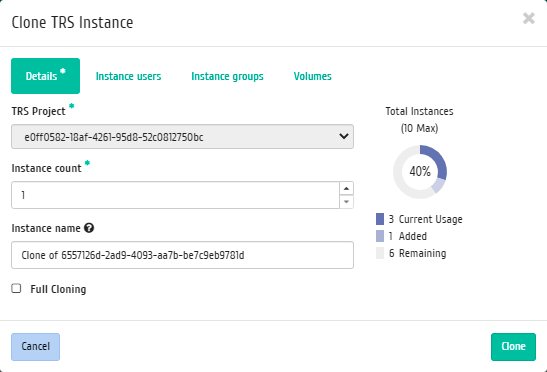
Cloning TRS instance window¶
Window is identical to the instance creation form and already contains all parameters of cloned TRS instance. All parameters, with the exception of TRS project, can be changed. The default name is changed and looks like “Clone of <name of the cloned instance>”.
End procedure with «Clone» button.
If “Full cloning” option is checked, possibility of editing TRS instance clone will disappear, full clone of the original TRS instance will be created by creating snapshot and starting the instance from created snapshot. Then snapshot is deleted automatically. Full clone of instance will also clone all the instance’s tags, metadata, attached volumes, assigned users and groups. Default name is “Full clone of <name of the cloned machine>”.
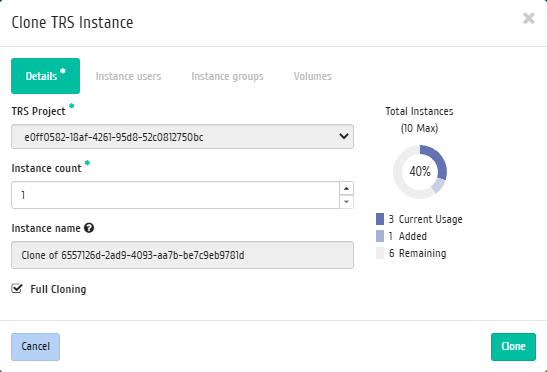
Full cloning of instance¶
Waking up instance¶
If TRS instance with Windows goes to sleep, then there is no connection to it via rdp protocol, this causes instance to be suspended in OpenStack. This function allows to wake up selected instance. Available in the general list of all instances. After calling the action in the window that opens, confirm awakening of the instance:

Instance data change window¶
Note
In order for functionality of waking up instances to be available, it is necessary that the Agent module is installed and configured on the compute node, and the module CloudManager is installed on the controller.
After performing the action, power status of the instance changes from «Suspended» to «Active».
Assigning users¶
Function is available in the general list of all instances. It allows to manage TRS instance users. For user without administrator rights, assignment is possible only on instances of available projects. Multiple user assignment is only available to the administrator.
After calling action in the window that opens, assign the necessary users:
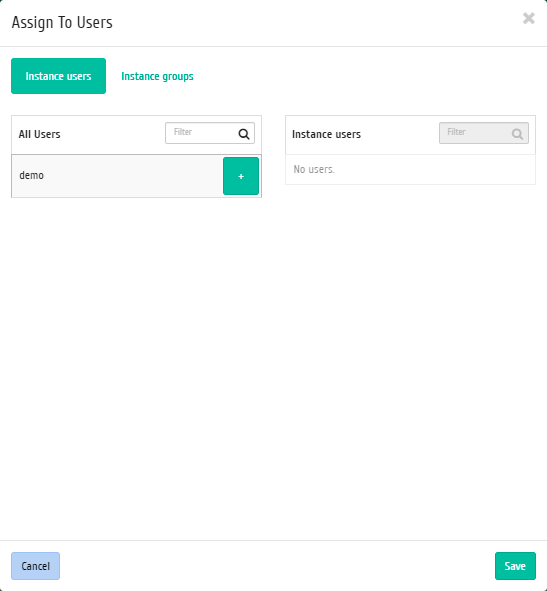
Instance user management window¶
End procedure with «Save» button.
All operations by assigning users are displayed in «Action Log» tab.
Rebuilding TRS instance¶
Function allows to change the boot source of the selected instance. It is available in general list of all instances. After calling the action in the window that opens, select the necessary parameters:
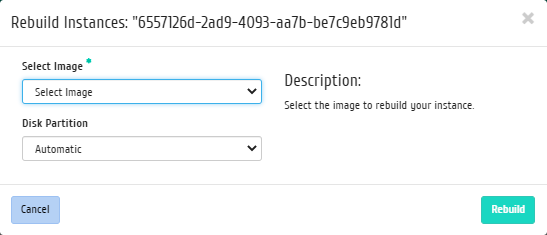
Window for changing the boot source of instance¶
After selecting source, you also need to specify how the instance’s volume is partitioned. We finish procedure with the confirmation button.
Scheduling actions on TRS instance¶
Select required TRS instance and invoke action:

Scheduled action calendar¶
In the wizard window that opens, select the date. Highlighted days indicate the presence of planned actions on this object for the date, and blue marks indicate their number.
To go to the next step in the field of the selected date, click on an empty area or number. In the first case, you will be redirected to the task creation window. When you click on the number, you will be immediately prompted to select the duration:

Scheduled action calendar¶
Specify the rest of the parameters of the scheduled action, which contain the internal tabs of the master window:

Task creation window¶
Let’s analyze their content in more detail:
Select an action:
- Task name is the name of the scheduled action; if empty, it will be generated automatically;
- Action is list of available actions on the instance:
- Create snapshot;
- Pause instance;
- Hard reboot instance;
- Rebuild instance;
- Rescue instance;
- Resume instance;
- Shelve instance;
- Shut Off instance;
- Start instance;
- Unpause instance;
- Unshelve instance;
- Run openstack shell command;
- Run curl request.
User credentials:
- Username is the login of the user planning the action;
- Password is password of the user planning the action;
- Project is working project of user planning the action.
Details:
- Type is the type of task. Following types are distinguished:
- Single task;
- Repeating task.
- Repeat, selection of values of the task execution interval. Following options are available:
- Days;
- Hours;
- Minutes;
- Working days (from Monday to Friday);
- Days of the week;
- Year.
- Repeat with interval, selection of task execution interval;
- Start date is the start date of the task in the format dd.mm.yyyy;
- Start time is the start time of the task in the format hh.mm;
- Time zone is the time zone according to which the task execution time is indicated;
- End is the conditions for terminating the task. Following conditions are distinguished:
- Never, when choosing a flag, the task becomes unlimited;
- Max number of repetitions is limiting the number of task executions;
- Date is the deadline for the task execution, set in the format dd.mm.yyyy.
End the procedure with the confirmation button.
Note
To return to the page with the calendar and change the date, use the «Cancel» button.
Created task is displayed in the tab «Scheduled tasks».
Member and group management¶
Function is available on the top panel in the general list of all TRS instances. Select the required ones and call the action “Manage members and groups”.
Important
Changing the parameters of instances is possible only within one project, otherwise corresponding error message will be displayed.
In the window that opens, set necessary parameters for selected TRS instances:

Instance user management window¶
- Instance users:
- All users is list of all available users of the project;
- Instance users are users selected to be assigned to these TRS instances.
- Project groups:
- All groups is list of all available user groups of the project;
- Instance groups are user groups selected to be assigned to these TRS instances.
Confirm changes with «Save» button.
